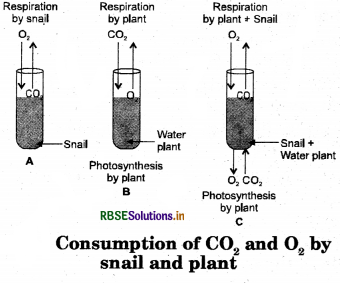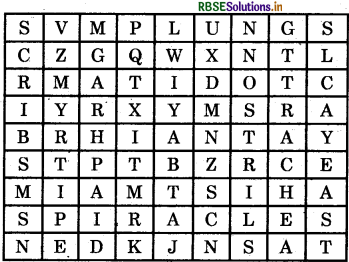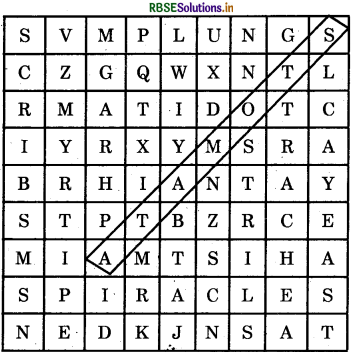RBSE Solutions for Class 7 Science Chapter 10 Respiration in Organisms
Rajasthan Board RBSE Solutions for Class 7 Science Chapter 10 Respiration in Organisms Textbook Exercise Questions and Answers.
Rajasthan Board RBSE Solutions for Class 7 Science in Hindi Medium & English Medium are part of RBSE Solutions for Class 7. Students can also read RBSE Class 7 Science Important Questions for exam preparation. Students can also go through RBSE Class 7 Science Notes to understand and remember the concepts easily. The class 7 science chapter 4 heat extra questions are curated with the aim of boosting confidence among students.
RBSE Class 7 Science Solutions Chapter 10 Respiration in Organisms
RBSE Class 7 Science Respiration in Organisms InText Questions and Answers
Page 110
Question 1.
Boojho noticed that when he released his breath after holding it for some time, he had to breathe heavily. Can yon tell him why it was so?
Answer:
While releasing the breath, after a period of holding it, our body faces a period of oxygen deficiency. As all cells require oxygen for respiration, upon releasing breath, the body tries to take in more oxygen to make up for this period of deficiency. Hence, as a reflex the body starts breathing heavily.

Page 111
Question 2 .
Paheli wants to know, why we yawn when we are sleepy or drowsy?
Answer:
This is because we are sleepy or drowsy due to low oxygen levels in our body. In order to overcome this energy less state of the body, our body yawns as a reflex action. This allows the intake of a large amount of air in a single breath, to supply more oxygen to the blood and cells for more energy production.
Page 114
Question 3.
Boojho wants to know, how much air can a person hold in the lungs?
Answer:
On an average, the amount of air that can be held by a person’s lungs varies between 4 litre to 6 litre. This is also known as the lung capacity. It also varies from person to person depending upon the age, gender, diseases, etc.
Page 115
Question 4.
Boojho wants to know, if cockroaches, snails, fishes, earth - worms, ants and mosquitoes also have lungs.
Answer:
Cockroaches, fishes, earthworms, ants and mosquitoes don’t have lungs. However, some type of snails may have a lung like organ.
Page 116
Question 5.
Boojho has seen in television programmes that whales and dolphins often come up to the water surface. They even release a fountain of water sometimes while moving upwards. Why do they do so?
Answer:
Whales and dolphins have to come up to the surface to breath air. While doing so, they open their nose also called a blowhole situated on top of their head. It blows out a gust of old moist air in a spout of air and water as they breathe.
Question 6.
Paheli wants to know whether roots, which are underground also take in oxygen. If so, how?
Answer:
Roots also take in oxygen. They do so by the process of diffusion of air molecules present in between the soil particles into intracellular spaces present in their roots.
RBSE Class 7 Science Respiration in Organisms Textbook Questions and Answers
Question 1.
Why does an athlete breathe faster and deeper than usual after finishing the race?
Answer:
As the athlete is running, a lot more energy is being consumed compared to the resting state. Hence, to generate more energy, the rate of aerobic respiration needs to be increased. The oxygen requirement as a result is higher. Therefore, an athlete breathes faster and deeper to take in more oxygen.
Question 2.
List the similarities and differences between aerobic and anaerobic respiration.
Answer:
Similarities:
(i) Both types of respiration use glucose as the substrate.
(ii) Both occur inside a cell.
(iii) Both produce energy.
(iv) Both produce CO2 as a by - product.
Differences:
|
Characteristics |
Aerobic |
Anaerobic |
|
Requirement of oxygen |
Required |
Not required |
|
Oxidation status of glucose |
Completely oxidized |
Incompletely oxidized |
|
End products |
CO2 + H2O + Energy |
CO2 + Alcohol + Energy |
|
Energy produced |
Much more |
Very less |
|
Occurrence |
In higher organisms |
Generally, in lower organisms |
|
Reaction Site of reaction |
Glucose + Oxygen + Carbon dioxide + Energy + Water |
Glucose + Alcohol + Carbon dioxide + Energy |
Question 3.
Why do we often sneeze, when we inhale a lot of dust - laden air?
Answer:
Most of the air we breathe in, is filtered to remove any dust, pollen or other particles from entering our lungs. This process is carried out by the hair present in the nostrils or the mucus secreted. In case, if some particles manage to bypass both these things and reach the nasal cavity, then it irritates the lining of mucus membranes. As a result, we sneeze to expel the foreign particles through nasal passage so that only clean air reaches the lungs.
Question 4.
Take three test tubes. Fill 3 / 4th of each with water. Label them A, B and C. Keep a snail in test tube A, a water plant in test tube B and in C, keep snail and plant both. Which test tube would have the highest concentration of CO2?
Answer:
As shown in figure A, respiration of snail consumes O2 and releases CO2. In figure B, plant releases O2 and consumes CO2 for food synthesis by the process of photosynthesis.

In figure C, the plant is releasing O2 which is consumed by the snail for the respiration. On the other hand, snail gives out CO2 which in turn consumed by the plant for food synthesis. Therefore, as only tube 'A' has no mechanism to use up the CO2 produced, it is the tube with the maximum concentration of CO2.
Question 5.
Tick the correct answers:
(a) In cockroaches, air enters the body through:
(i) lungs
(ii) gills
(iii) spiracles
(iv) skin
Answer:
(iii) spiracles.
(b) During heavy exercise, we get cramps in the legs due to the accumulation of:
(i) carbon dioxide
(ii) lactic arid
(iii) alcohol
(iv) water
Answer:
(ii) lactic acid.
(c) Normal range of breathing rate per minute in an average adult person at rest is:
(i) 9 - 12
(ii) 15 - 18
(iii) 21 - 24
(iv) 30 - 33
Answer:
(ii) 15 - 18.
(d) During exhalation, the ribs:
(i) move outwards
(ii) move downwards
(iii) move upwards
(iv) do not move at all
Answer:
(ii) move downwards.

Question 6.
Match the items in Column I with those in Column II:
|
Column I |
Column II |
|
(a) Yeast |
(i) Earthworm |
|
(b) Diaphragm |
(ii) Gills |
|
(c) Skin |
(iii) Alcohol |
|
(d) Leaves |
(iv) Chest cavity |
|
(e) Fish |
(v) Stomata |
|
(f) Frog |
(vi) Lungs and skin |
Answer:
|
Column I |
Column II |
|
(a) Yeast |
(iii) Alcohol |
|
(b) Diaphragm |
(iv) Chest cavity |
|
(c) Skin |
(i) Earthworm |
|
(d) Leaves |
(v) Stomata |
|
(e) Fish |
(ii) Gills |
|
(f) Frog |
(vi) Lungs and skin |
Question 7.
Mark ‘T’ if the statement is true and 'F' if it is false:
(i) During heavy exercise, the breathing rate of a person slows down. (T/F)
(ii) Plants cany out photosynthesis only during the day and respiration only at night. (T/F)
(iii) Frogs breathe through their skins as well as their lungs. (T/F)
(iv) The fishes have lungs for respiration. (T/F)
(v) The size of the chest cavity increases during inhalation. (T/F)
Answer:
(i) False
(ii) False
(iii) True
(iv) False
(v) True.
Question 8.
Given below is a square of letters in which are hidden different words related to respiration in organisms. These words may be present in any direction - upwards, downwards, or along the diagonals. Find the words for your respiratory system. Clues about those words are given below the square:

(i) The air - tubes of insects
(ii) Skeletal structures surrounding chest cavity
(iii) Muscular floor of chest cavity
(iv) Tiny pores on the surface of leaf
(v) Small openings on the sides of the body of an insect
(vi) The respiratory organs of human beings
(vii) The openings through which we inhale
(viii) An anaerobic organism
(ix) An organism with tracheal system.
Answer:

(i) The air tubes of insects → Trachea
(ii) Skeletal structures surrounding chest cavity → Ribs
(iii) Muscular floor of chest cavity → Diaphragm
(iv) Tiny pores on the surface of leaf → Stomata
(v) Small openings on the sides of the body of an insect → Spiracles
(vi) The respiratory organs of human beings → Lungs
(vii) The openings through which we inhale → Nostrils
(viii) An anaerobic organism → Yeast
(ix) An organism with tracheal system → Ant
Question 9.
The mountaineers carry oxygen with them, because:
(a) At an altitude of more than 5 km, there is no air.
(b) The amount of air available to a person is less than that available on the ground.
(c) The temperature of air is higher than that on the ground.
(d) The pressure of air is higher than that on the ground.
Answer:
(b) The amount of air available to a person is less than that available on the ground.

- RBSE Class 7 Science Notes in Hindi & English Medium Pdf Download
- RBSE Class 7 Science Important Questions in Hindi Medium & English Medium
- RBSE Solutions for Class 7 Science in Hindi Medium & English Medium
- RBSE Class 7 Science Important Questions Chapter 1 Nutrition in Plants
- RBSE Class 7 Science Notes Chapter 1 Nutrition in Plants
- RBSE Class 7 Science Important Questions Chapter 14 Electric Current and its Effects
- RBSE Class 7 Science Important Questions Chapter 13 Motion and Time
- RBSE Class 7 Science Important Questions Chapter 2 Nutrition in Animals
- RBSE Class 6 Science Notes Chapter 8 शरीर में गति
- RBSE Class 7 Science Notes Chapter 18 Wastewater Story
- RBSE Class 7 Science Notes Chapter 17 Forests: Our Lifeline